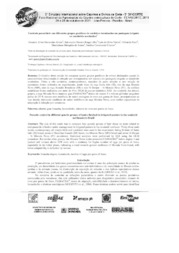Controle parasitário em diferentes grupos genéticos de cordeiros terminados em pastagem irrigada no Semiárido Nordestino.
Controle parasitário em diferentes grupos genéticos de cordeiros terminados em pastagem irrigada no Semiárido Nordestino.
Author(s): FERNANCES JÚNIOR, G. A.; LOBO, R. N. B.; VIEIRA, L. da S.; FACO, O.; SOUSA, M. M. de; CHAVES, S. C.
Summary: Resumo: O objetivo desse estudo foi comparar quatro grupos genéticos de ovinos deslanados quanto às características relacionadas à infecção por endoparasitas sob manejo em pastagem irrigada no semiárido nordestino. Trinta e três cordeiros, contemporâneos, nascidos de parto simples e sem relação de parentesco foram utilizados no experimento, sendo treze da raça Santa Inês (SI), seis da raça Morada Nova (MN), sete da raça Somalis Brasileira (SB) e sete ½ Dorper ? ½ Morada Nova (F1). As análises estatísticas foram realizadas por meio do Proc GLM do pacote estatístico SAS. Ao contrário dos demais grupos, a raça Morada Nova manteve grau FAMACHA © abaixo do escore 3 e volume globular sanguíneo acima de 23 % mesmo com tendência de maior contagem de ovos por grama de fezes, principalmente na fase inicial, indicando tendência de maior resiliência da raça Morada Nova, com melhor capacidade de adaptação à infecção por verminose. Abstract: The aim of this study was to compare four genetic groups of hair sheep on traits related to endoparasitic infection under management in irrigated pasture in the semiarid northeast. Thirty-three male lambs, contemporary, all simple birth and unrelated were used in the experiment, being thirteen of Santa Inês (SI) breed, seven of Brazilian Somali (SB) breed, six Morada Nova (MN) breed and seven ½ Dorper ? ½ Morada Nova (F1) crossbreed. Statistical analyses were performed by SAS using the GLM procedure. But unlike other groups, the Morada Nova lambs presented FAMACHA © below degree 3 and packed cell volume above 23% even with a tendency for higher number of eggs per gram of feces, especially in the initial phase, indicating a trend towards greater resilience of Morada Nova breed, with better adaptability to infection by worms.
Publication year: 2011
Types of publication: Paper in annals and proceedings
Unit: Embrapa Goats & Sheep
Observation
Some of Embrapa's publications are published as ePub files. To read them, use or download one of the following free software options to your computer or mobile device. Android: Google Play Books; IOS: iBooks; Windows and Linux: Calibre.
Access other publications
Access the Agricultural Research Database (BDPA) to consult Embrapa's full library collection and records.
Visit Embrapa Bookstore to purchase books and other publications sold by Embrapa.

